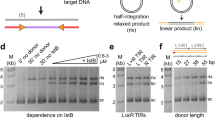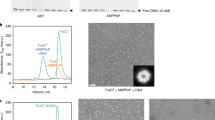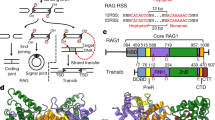Abstract
The integrase family of site-specific recombinases catalyze a diverse array of DNA rearrangements in archaebacteria, eubacteria and yeast. The solution structure of the DNA binding domain of the integrase protein from the conjugative transposon Tn 916 has been determined using NMR spectroscopy. The structure provides the first insights into distal site DNA binding by a site-specific integrase and reveals that the N-terminal domain is structurally similar to the double stranded RNA binding domain (dsRBD). The results of chemical shift mapping experiments suggest that the integrase protein interacts with DNA using residues located on the face of its three stranded β-sheet. This surface differs from the proposed RNA binding surface in dsRBDs, suggesting that different surfaces on the same protein fold can be used to bind DNA and RNA.
This is a preview of subscription content, access via your institution
Access options
Subscribe to this journal
Receive 12 print issues and online access
$189.00 per year
only $15.75 per issue
Buy this article
- Purchase on Springer Link
- Instant access to full article PDF
Prices may be subject to local taxes which are calculated during checkout




Similar content being viewed by others
References
Scott, J.R. & Churchward, G. Annu. Rev. Microbiol. 49, 367–397 (1995).
Clewell, D.B. & Flannagan, S.E. In Bacterial conjugation (ed. Clewell, D.B.) 369–393 (Plenum, New York; 1993).
Clewell, D.B. Flannagan, S.E. & Jaworski, D.D. Trends Microbiol. 3, 229 –236 (1995).
Argos, P. et al. EMBO J. 5, 433–440 ( 1996).
Glasgow, A.C. Hughes, K.T. & Simon, M.L. In Mobile DNA (eds Berg, D.E. &Howe, M.M.) 637–659 (American Society of Microbiology, Washington DC; 1989).
Blakely, G. et al. Cell 75, 351–361 ( 1993).
Hoess, R.H. & Abremski, K. In Nucleic Acids and Molecular Biology (eds Eckstein, F. & Lilley, D.M.J.) 99– 109 (Springer-Verlag, Berlin; 1990).
Cox, M.M. In Mobile DNA (eds Berg, D.E. & Howe, M.M.) 661–670 (American Society of Microbiology, Washington DC; 1989).
Golden, J.W. Robinson, S.L. & Haselkorn, R. Nature 314, 419– 423 (1985).
Stragier, P. Kunkel, B. Kroos, L. & Losick, R. Science 243, 507–512 (1989).
Thompson, J.F. & Landy, A. In Mobile DNA (eds Berg, D.E. & Howe, M.M.) 1–22 (American Society of Microbiology, Washington DC; 1989).
Lu, F. & Churchward, G. EMBO J. 13, 1541–1548 (1994).
Landy, A. Ann. Rev. Biochem. 58, 913–949 ( 1989).
Gou, F., Gopaul, D.N. & Van Duyne, G.D. Nature 389, 40– 46 (1997).
Hickman, A.B. Waninger, S. Scocca, J.J. & Dyda, F. Cell 89, 227–237 (1997).
Kwon, H.J. Tirumalai, R. Landy, A. & Ellenberger, T. Science 276 (1997).
Subramanya, H.S. et al. EMBO J. 16, 5178–5187 (1997).
Wilmot, C.M. & Thornton, J.M. J. Mol. Biol. 203, 221–232 (1988).
Presta, L.G. & Rose, G.D. Science 240, 1632–1641 (1988).
Ramakrishnan, V. & White, S.W. Nature 358, 768–771 (1992).
Burd, C.G. & Dreyfuss, G. Science 265, 615–620 (1994).
Bycroft, M. Grunert, S. Murzin, A.G. Proctor, M. & St. Johnson, D. EMBO J. 14,3563– 3571 (1995).
Kharrat, A. Macias, M.J. Gibson, T.J. Nilges, M. & Pastore, A. EMBO J. 14, 3572– 3584 (1995).
Ferrandon, D. Elphick, L. Nüsslein-Volhard, C. & St. Johnson, D. Cell 79, 1221–1231 ( 1994).
Bax, A. & Grzesiek, S. Acct. Chem. Res. 26, 131–138 (1993).
Clore, G.M. & Gronenborn, A.M. Science 252, 1390–1399 (1991).
Clore, G.M. & Gronenborn, A.M. (eds) NMR of proteins (CRC Press, Ann Arbor, Michigan; 1993).
Bax, A. et al. Meth. Enzs. 239, 79–106 (1994).
Delaglio, F. J. Biomolec. NMR 6, 277–293 ( 1995).
Garrett, D.S. Powers, R. Gronenborn, A.M. & Clore, G.M. J. Magn. Reson. 95, 214–220 ( 1991).
Nilges, M. Prot. Struct. Funct. Genet. 17, 295–309 (1993).
Ponder, J.W. & Richards, F.M. J. Mol. Biol. 193, 775–791 (1987).
Brünger, A.T. X-PLOR Manual, Version 3.1. (Yale University, New Haven, Connecticut; 1993).
Garrett, D.S. J. Magn. Reson. Series B 104, 99–103 (1994).
Kuszewski, J. Qin, J., Gronenborn, A.M. & Clore, G.M. J. Magn. Reson. Series B 106, 92–96 (1996).
Kuszewski, J. Gronenborn, A.M. & Clore, G.M. Prot. Sci. 5, 1067– 1080 (1996).
Nilges, M. Clore, G.M. & Gronenborn, A.M. FEBS Lett. 229, 129– 136 (1988).
Koradi, R. Billeter, M. & Wuthrich, K. J. Mol. Graphics 14, 51–55 (1996).
Kraulis, P.J. J. Appl. Crystallogr. 24, 946–950 (1991).
Acknowledgements
We thank T. Dieckmann and M. Grzeskowiak for technical support; D. Garrett for the program PIPP and F. Delaglio for the program NMRPipe, J. Omichinski for useful discussions and G. Churchward for the Tn916 integrase clone. This work was supported by a grant from the U.S. Department of Energy.
Author information
Authors and Affiliations
Corresponding author
Rights and permissions
About this article
Cite this article
Connolly, K., Wojciak, J. & Clubb, R. Site-specific DNA binding using a variation of the double stranded RNA binding motif. Nat Struct Mol Biol 5, 546–550 (1998). https://doi.org/10.1038/799
Received:
Accepted:
Issue Date:
DOI: https://doi.org/10.1038/799
This article is cited by
-
Genetic information from discordant sibling pairs points to ESRP2 as a candidate trans-acting regulator of the CF modifier gene SCNN1B
Scientific Reports (2020)
-
Molecular characterization and roles of AP2 transcription factors on drought tolerance in plants
Frontiers of Agriculture in China (2011)
-
Genome dynamics and its impact on evolution of Escherichia coli
Medical Microbiology and Immunology (2010)



